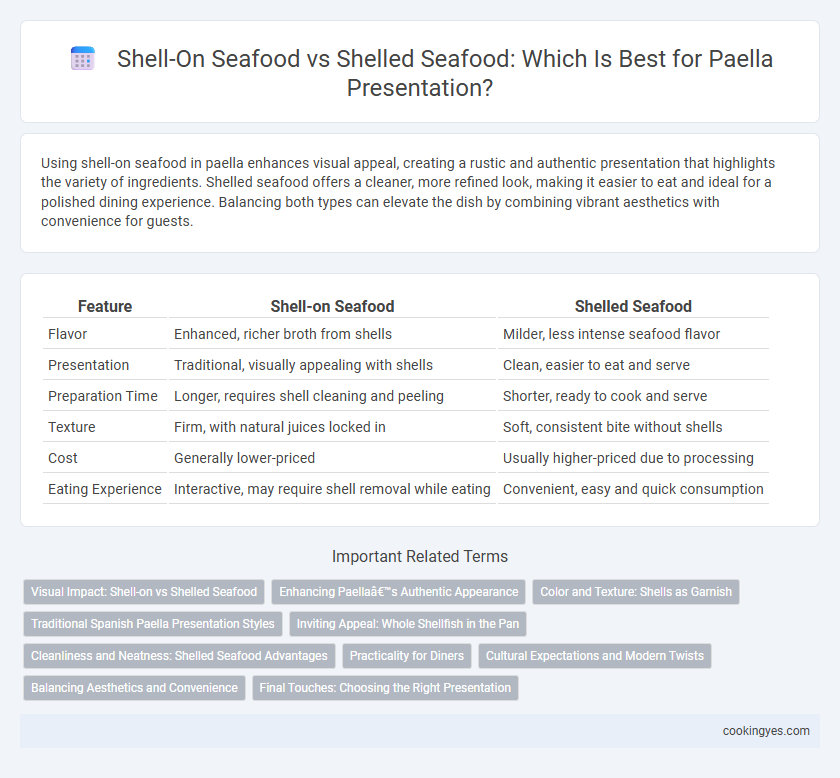Using shell-on seafood in paella enhances visual appeal, creating a rustic and authentic presentation that highlights the variety of ingredients. Shelled seafood offers a cleaner, more refined look, making it easier to eat and ideal for a polished dining experience. Balancing both types can elevate the dish by combining vibrant aesthetics with convenience for guests.
Table of Comparison
| Feature | Shell-on Seafood | Shelled Seafood |
|---|---|---|
| Flavor | Enhanced, richer broth from shells | Milder, less intense seafood flavor |
| Presentation | Traditional, visually appealing with shells | Clean, easier to eat and serve |
| Preparation Time | Longer, requires shell cleaning and peeling | Shorter, ready to cook and serve |
| Texture | Firm, with natural juices locked in | Soft, consistent bite without shells |
| Cost | Generally lower-priced | Usually higher-priced due to processing |
| Eating Experience | Interactive, may require shell removal while eating | Convenient, easy and quick consumption |
Visual Impact: Shell-on vs Shelled Seafood
Shell-on seafood in paella enhances visual impact by adding vibrant colors and textures that showcase the dish's freshness and variety. The intact shells create a rustic, authentic appearance, making the dish more visually appealing and inviting. Shelled seafood, while convenient, results in a cleaner but less dramatic presentation, often reducing the visual complexity that shell-on ingredients provide.
Enhancing Paella’s Authentic Appearance
Using shell-on seafood in paella significantly enhances its authentic appearance by showcasing vibrant colors and textures, reflecting traditional Spanish culinary artistry. The presence of shells, such as shrimp, mussels, and clams, adds visual appeal and depth, making the dish more inviting and true to its roots. Shelled seafood may simplify eating but often reduces the visual impact and the rustic charm essential to classic paella presentations.
Color and Texture: Shells as Garnish
Shell-on seafood enhances the visual appeal of paella by providing vibrant, contrasting colors such as the deep reds of prawns and bright oranges of mussels, making the dish more attractive and authentic. The shells act as natural garnishes, adding a rustic texture that complements the soft, tender grains of saffron-infused rice. The slight crunch from the shells also creates a dynamic eating experience, balancing the overall texture of the paella.
Traditional Spanish Paella Presentation Styles
Traditional Spanish paella often features shell-on seafood, including whole mussels, clams, and prawns, which enhance flavor complexity and provide visual appeal. The shells release natural juices during cooking, enriching the broth and rice with authentic maritime essence. Shelled seafood is sometimes used for convenience but typically lacks the depth of taste and the striking presentation that shell-on seafood delivers in classic recipes.
Inviting Appeal: Whole Shellfish in the Pan
Whole shell-on seafood in paella enhances visual appeal by showcasing vibrant colors and textures that capture diners' attention. The intact shells lock in natural juices, enriching the dish's flavor while providing an authentic dining experience. Presenting whole shellfish creates a festive, inviting atmosphere that highlights the traditional essence of paella.
Cleanliness and Neatness: Shelled Seafood Advantages
Shelled seafood enhances the cleanliness and neatness of a paella presentation by eliminating shells that can clutter the dish and complicate eating. This preparation allows diners to focus on the vibrant colors and textures of the seafood without distraction, creating a visually appealing and tidy plate. Removing shells also reduces the risk of shell fragments in the dish, ensuring a more pleasant and hygienic dining experience.
Practicality for Diners
Shell-on seafood in paella enhances presentation and flavor while offering diners an interactive and authentic experience, though it requires more effort to eat. Shelled seafood provides practicality by allowing guests to enjoy the dish easily and quickly, reducing mess and minimizing distractions during meals. Choosing shell-on or shelled seafood depends on balancing culinary tradition with diner convenience and comfort.
Cultural Expectations and Modern Twists
Shell-on seafood in paella honors traditional Spanish culinary culture, showcasing vibrant presentation and enhanced flavor from cooking in the shell. Shelled seafood offers a modern twist, catering to contemporary preferences for convenience and ease of eating while maintaining freshness and taste. Balancing cultural expectations with innovative dining trends allows chefs to appeal to both purists and modern diners in paella presentations.
Balancing Aesthetics and Convenience
Shell-on seafood enhances the visual appeal of paella by showcasing vibrant colors and natural textures, creating an authentic Mediterranean presentation that impresses diners. Shelled seafood offers convenience and ease of eating, reducing preparation time and minimizing mess, which is ideal for casual settings or quick service. Balancing these options depends on the dining experience desired, with shell-on seafood elevating elegance and shelled seafood prioritizing practicality.
Final Touches: Choosing the Right Presentation
Shell-on seafood enhances paella presentation by adding vibrant color, texture, and a rustic appeal that captivates diners. Shelled seafood offers ease of eating and streamlined flavor distribution, highlighting the saffron-infused rice without distraction. Selecting shell-on seafood elevates visual impact and authentic experience, while shelled options prioritize convenience and refined texture in the final presentation.
Shell-on Seafood vs Shelled Seafood for Paella presentation Infographic

 cookingyes.com
cookingyes.com